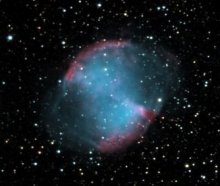
By Messier Number
By NGC Number
246, 650 & 651, 2438, 3587, 6953, 7293
By Other Catalog Number
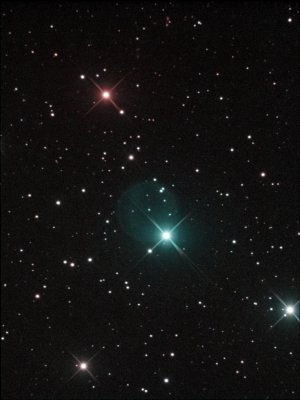
10-inch Newtonian, ST2000XM, 64:12:24:24
This planetary is like a ghost, just flickering at the edge of our vision. It is extremely faint and the bright (7.2 mag.) star right on the edge makes the imaging difficult. This is a foreground star and not associated with the nebula. The central star, which provided the gas that formed the nebula, looks to me like it is slightly off-center in the bubble. Except for some slight mottling along the left edge, the bubble is featureless.
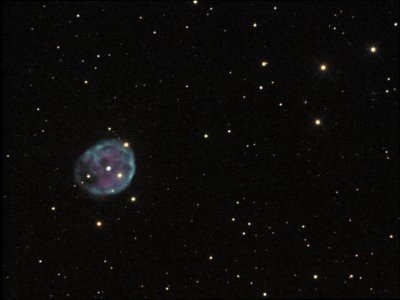
10-inch Newtonian, ST2000XM, 64:20:20:20
NGC 246 is a beautiful planetary nebula in Cetus. It is known as the Skull Nebula. The magnitude is 8.0, making it a fairly bright nebula, and the diameter is 4.1'. The central star is a white dwarf.
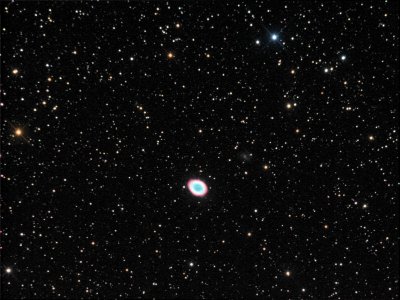
10-inch Newtonian, ST2000XM, 10:14:14:14
Everyone probably recognizes the famous Ring Nebula. This is a very mediocre image which I took while I was checking out some equipment modifications. It is essentially an RGB image, since I took almost no luminance. I decided to go ahead and include it until I can get a better one. Notice the faint two-armed spiral, IC 1296, a few arc minutes above and to the right of M57.
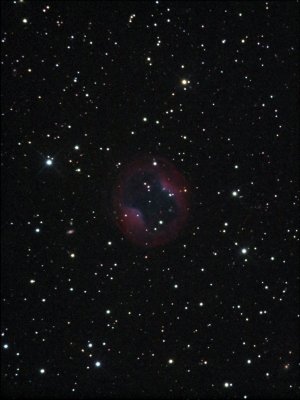
10-inch Newtonian, ST2000XM, 60:20:20:20
This is a very pretty object but would have benefitted from several times as much exposure. It is very faint, almost ghostly, and has quite a bit of structure that does not show up here. We are looking at the end of life of a star just a bit bigger than our sun. The expanding shells of gas will become too faint to be seen in just a few thousand years but the central white dwarf star will remain for billions of years.
An alternate name for this object is Jones-Emberson 1.
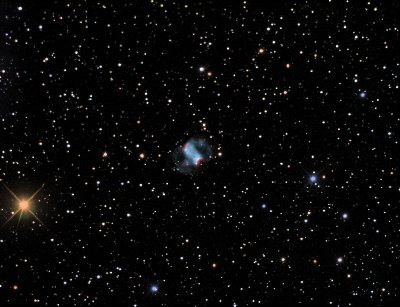
10-inch Newtonian, ST2000XM, 60:32:36:36
This planetary is usually called the "Little Dumbbell". It was originally cataloged in the NGC as two objects, NGC 650 and 651. It is one of the more irregular planetary nebulae. My image shows the brighter arcs of gas surrounding the central bar, but there is a lot more to be seen in very long exposures. If you stare long and hard at my full size image, you can detect some faint wisps essentially at the noise level outside the brighter arcs. It would probably take 10+ hours of exposure with my equipment to even start to show detail in these structures.
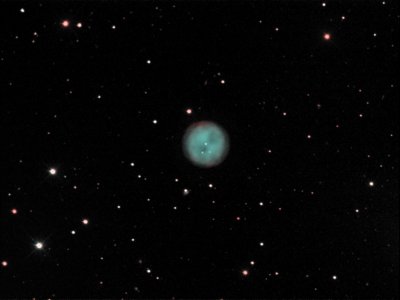
10-inch Newtonian, ST2000XM, 40:20:20:20 minutes
Messier 97, the Owl, is a beautiful planetary nebula right off the corner of the bowl of the Big Dipper. The pale green color is detectable visually in a moderate size telescope. There are many tiny background galaxies in the field, best seen in the full size image.
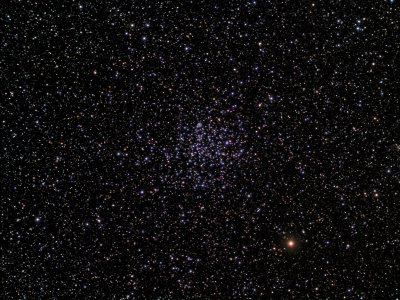
Astro-Tech AT66ED, ST2000XM, 24:20:16:16 minutes, 76' x 102'
The large, rich, blue open cluster is M46 (NGC 2437),and the tiny planetary is NGC 2438. NGC 2438 is very nearly a twin of the Ring Nebula, but much smaller. While it appears to be part of the cluster, it is now thought to be just a chance alignment.
I find the percentage of blue stars within the cluster compared to the percentage outside the cluster to be striking. With NGC 2438 and the very orange bright star SW of the cluster, it is a colorful and beautiful field. This is another image from my observatory in West Point, TX.
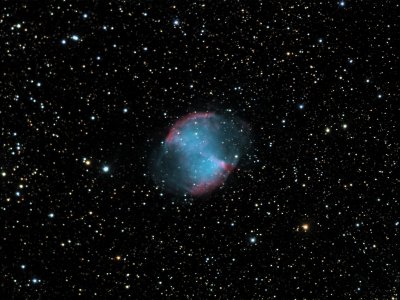
NGC 6953 (M27, The Dumbbell)
10-inch Newtonian, ST2000XM, 20:20:20:20 Minutes
M27 is probably the second most photographed of the summer Messier objects, after M57, The Ring. It is located in a beautiful Milky Way star field, adding to the impression both visually and photographically. The faint central star has, according to Burnham, a surface temperature near 85,000 degrees K, making it extremely blue.
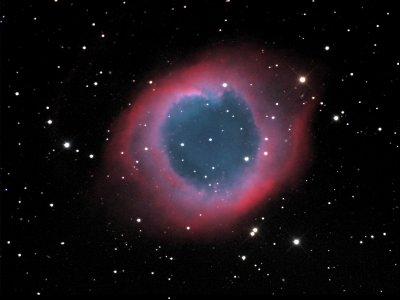
NGC 7293 (Helix)
10-inch Newtonian, ST2000XM, 92:64:64:64 minutes
The Helix is perhaps my favorite image so far. It is a big, colorful, spectacular object. It is a challenge visually because it is very large --about half the diameter of the full moon -- and has a fairly low surface brightness. Like M27, the central star is extremely hot, in this case calculated at over 100,000 degrees K.
Also notice the very faint tail of gas sweeping N from the SE edge of the body. You will have to look very closely to see it in these images.










